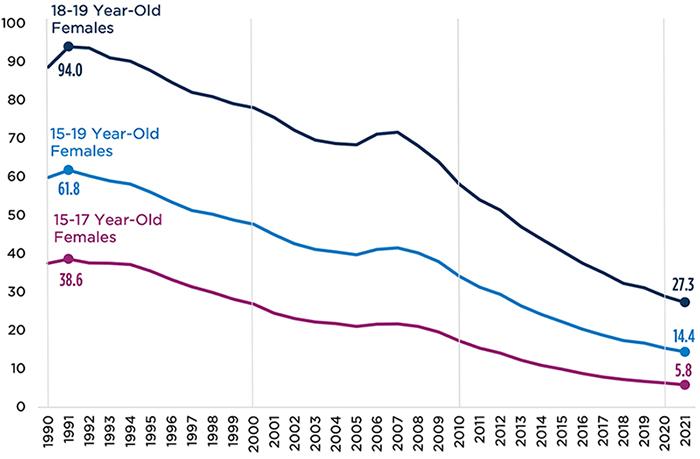The 30-Year Decline in Teen Birth Rates Has Accelerated Since 2010
Among female teens, birth rates have declined 77 percent in the past 30 years. Child Trends compiled data from the National Center for Health Statistics to determine that birth rates have declined from a post-1975 peak of 61.8 births per 1,000 females ages 15 to 19 in 1991 to 14.4 births per 1,000 in 2021.
- The decline has accelerated in the past decade: Teen birth rates dropped 20 percent from 1990 to 2000, 28 percent from 2000 to 2010, and 55 percent from 2010 to 2020 (declines continued into 2021).
- Birth rates for older teens are much higher than for younger teens. In 2021, there were 27.3 births per 1,000 females ages 18 and 19, compared with 5.8 births per 1,000 females ages 15 to 17.
Teen Birth Rates From 1990 to 2021, by Age
Births per 1,000 females, highlighting a post-1975 peak in 1991 and the current 2021 low

Sources: Data for 1990-2015 come from the National Center for Health Statistics’ 2015 National Vital Statistics Report. Data for 2016-2020 are drawn from the National Center for Health Statistics’ 2020 National Vital Statistics Report. Data for 2021 come from the National Center for Health Statistics’ Vital Statistics Rapid Release, Births: Provisional data for 2021.
In 2020, the birth rates for teens ages 15 to 19 who identified as Hispanic (23.5 births per 1,000), non-Hispanic Black (24.4), non-Hispanic American Indian/Alaska Native (25.7), and non-Hispanic Native Hawaiian or other Pacific Islander (22.6) remained higher than for teens who identified as non-Hispanic White (10.4) or non-Hispanic Asian (2.3).[1] Continued racial and ethnic disparities in health outcomes, including teen births, are tied to persistent structural and interpersonal racism in the United States.
Changes in teen birth rates are driven by changes in sexual activity and contraceptive use, although the relative role of each has varied over time. Two data sets are used to monitor trends in sexual activity and contraceptive use among teens in the United States—the Youth Risk Behavioral Surveillance System (YRBSS), which surveys youth enrolled in 9th to 12th grades, and the National Survey of Family Growth (NSFG), which includes adolescents ages 15 to 19.
Data on trends in sexual activity and contraceptive use vary somewhat across these data sets, likely due to differences in sampling strategies and how questions are worded. For example, data from the NSFG show that the percent of female teens ages 15 to 19 who had ever had sexual intercourse did not change much from 2002 to 2017. However, the YRBSS, which includes a slightly younger sample of youth, did show a decline in sexual experience over a similar time frame, especially among females in 9th and 10th grades. In fact, from 1991 to 2019, data from the YRBSS show a 29 percent decrease in the proportion of high school students who reported ever having had sex.
Footnote
[1] Final birth data by race and ethnicity for 2021 were not yet available when this data point was written.
Related Research
- Teen Births Have Declined by More Than Three Quarters Since 1991
- Lessons From a Historic Decline in Child Poverty
- State-level Data for Understanding Child Poverty
- Preventing Births to Teens Is Associated With Long-term Health and Socioeconomic Benefits, According to Simulation
- Preventing Births to Teens Is Associated With Long-term Health and Socioeconomic Benefits, According to Simulation
- El Camino: Helping Teens Set Life Goals and Promote Sexual Health
- School-based Strategies to Support Adolescent Sexual and Reproductive Health
Suggested Citation
Wildsmith, E., Welti, K., Finocharo, J., & Ryberg, R. (2022, December 23). The 30-year decline in teen birth rates has accelerated since 2010. Child Trends. https://www.childtrends.org/blog/the-30-year-decline-in-teen-birth-rates-has-accelerated-since-2010
© Copyright 2024 ChildTrendsPrivacy Statement
Newsletter SignupLinkedInThreadsYouTube